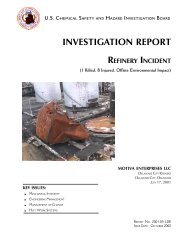CTA Report, Draft 1, ISP Review - US Chemical Safety and Hazard ...
CTA Report, Draft 1, ISP Review - US Chemical Safety and Hazard ...
CTA Report, Draft 1, ISP Review - US Chemical Safety and Hazard ...
You also want an ePaper? Increase the reach of your titles
YUMPU automatically turns print PDFs into web optimized ePapers that Google loves.
B.3 Minimum Ignition Energy<br />
The minimum ignition energy (MIE) test is useful to determine whether combustible dust/air mixtures are<br />
ignitable by a high-voltage spark. Ignition energies determined by this method can be compared to<br />
determine the relative hazard of ignition by sources such as electrostatic discharges, electrical equipment<br />
sparks, <strong>and</strong> friction sparks.<br />
Test results provide a relative measure of the ignition sensitivity of a dust cloud. The values obtained are<br />
specific to the sample, test method, <strong>and</strong> test equipment. MIE values are not to be considered intrinsic<br />
material constants. Any change in particle size, shape, or volatility alters MIE results. MIE tests were<br />
performed per ASTM E2019-99, St<strong>and</strong>ard Test Method for Minimum Ignition Energy of a Dust Cloud in<br />
Air (1999), using a 1.2-liter clear plastic Hartmann tube.<br />
Figure B-4 shows MIE test results for a Durite SD-52SS dust cloud in air. Results indicate that the<br />
phenolic resin is very easy to ignite, requiring only 3 millijoules (mJ) of energy to initiate an explosion.<br />
300<br />
250<br />
200<br />
MIE<br />
(mJ)<br />
150<br />
100<br />
50<br />
0<br />
3<br />
60<br />
300<br />
Cornstarch<br />
Pittsburgh Pulverized Coal<br />
Dust<br />
SD-52SS + Carbon Black #2<br />
Figure B-4. Minimum ignition energy of Durite SD-52SS<br />
compared with other common combustible dusts.<br />
106









